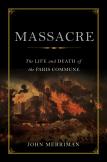To The Barricades!
An academic colleague living in France asserts that he has never encountered a country more evenly and implacably divided between left and right than France. John Merriman’s account of the Paris Commune of 1871 explores a historical root of this polarity.
In 1870, the Emperor Napoleon III launched a disastrous war with Prussia. His defeat resulted in the fall of the Second Empire, a siege and occupation of Paris, the loss of Alsace-Lorraine and the tentative establishment of a Third Republic. National elections in early 1871 returned a strong rightist majority that suggested a restoration of pre-revolutionary kingship. Paris, far to the left of the rest of the country, objected to this result. The ensuing uprising, the Commune, controlled the city for 64 days. The French government was forced to withdraw its forces to suburban Versailles, where they regrouped to capture the city brutally. Summary executions of Communards and people suspected of collaboration with them followed. Communards were equally ruthless about killing their opponents. Merriman’s account forces the reader to ponder which is bloodier, violence in the name of the state or violence in the name of the people. His answer is clearly that the state produces worse violence, as shown by the ultimate suppression of the Commune. However, he is even enough in his presentation to raise serious questions about popular revolutions as well.
Merriman, the Charles Seymour professor of history at Yale, sets forth these events in accessible fashion. He is a rare academic, informing general readers without sacrificing his scholarship. His book is a good combatant against today’s prevalent historical amnesia and, particularly, American ignorance of French history.
Napoleon III had already fallen from power when the Commune began, but he was a key villain of this tale. His redesign of Paris, which contributed toward the beautiful capital so familiar to visitors today, further impoverished the poor. By sharpening class divisions and hindering entry into the middle class, Napoleon III left behind conditions for a revolt. Furthermore, his sharp defeat by the Prussians humiliated all of France and made it hard for the new French state to establish credibility. Napoleon III serves as a warning today: avoid policies that divide social classes and foster winless wars.
Merriman is strongly biased toward the Communards, who were especially prescient about women’s rights and the ingredients of a future national welfare state. However, he glosses over the problematic process by which they pursued their ends. Their uprising was essentially a refusal to accept the result of a national election. Revolting just a decade after the secession of the Southern American states that rejected the election of Abraham Lincoln as president, the leftish Communards had something in common with rightist American slaveholders. Both the United States and France therefore faced a similar challenge to building stable republics in the 1870s, namely by persuading polarized factions to accept the legitimacy of each other.
Merriman well describes individual personalities among the Communards. He does not do as much for their opponents. The book would be more balanced with more attention to their lives and concerns.
A tragic Commune victim was the archbishop of Paris, Georges Darboy, who was executed by a Communard firing squad. Darboy actually understood that the French church had stifled evangelization through its association with Napoleon III. An intellectual preoccupied with the relationship between history and theology, Darboy was also alarmed that so many French males had left the church. He hoped to reconcile science and faith. Darboy also knew that the church needed to offer something more to the poor than talk of riches in eternal life. He was not unsympathetic to some Communard concerns.
To understand how Darboy was killed anyway, this book needs context on the international church during the Commune. Merriman does mention that the First Vatican Council defined papal infallibility. Opposed to the definition, the Gallican Darboy left Vatican I rather than vote on the schema and submitted to the teaching from home. Merriman portrays Darboy as a bishop whom Napoleon III appointed over the objections of the pope, who was unable to block this nomination due to a concordat giving the French state control of episcopal appointments. However, it should be added that Pius IX controlled the Papal States only as long as Napoleon III’s troops protected Rome. The Franco-Prussian War forced the emperor to remove them. Papal dependence on France was likely at least as important a factor in holding Darboy in office as the concordat itself. That Darboy was vulnerable to execution in the immediate months after Pius IX’s loss of Rome was not a coincidence. Many radicals worldwide saw the universal church as moribund at this time. The omission of the Roman context shows the limits of Merriman’s microscopic focus on events in Paris.
Elihu B. Washburne, American envoy to France and a comprehensive chronicler of the Commune, was not the “ambassador” that Merriman frequently calls him. In fact, the United States did not award this title to its diplomats until 1893. Washburne was merely a minister, which likely diminished American efforts to help.
Limited by an excessive focus on Paris itself and by a pronounced bias toward the Communards, this nonetheless remains a book with the capacity to lead readers to their own conclusions.
This article also appeared in print, under the headline “To The Barricades!,” in the May 4, 2015, issue.








